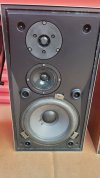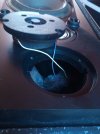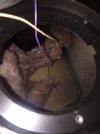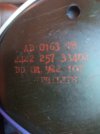The AMT tweeter by itself does not have a particular sound. What you hear from a loudspeaker is a culmination of the frequency response and radiation pattern, you can build two designs, one with an AMT, another with a dome tweeter, and tune both to sound the exact same.
There are these myths about low driver mass for better transient response, those people don't understand how speakers work. A driver with a higher mass is capable of achieving the same transient response and peak SPL if the motor strength is high enough. Motor strength is mostly just a matter of money, a bigger magnet and larger voice coil.
Any driver swap has the potential to make the speaker sound better or worse. Depends on how well the new driver integrates with the crossover, and if the original design was any good. Looking at the original Beovox S45-2 crossover, I see it only has a first order band-pass on the mid-range driver. Shallow slopes like that rarely sound good, often compromising the distortion and radiation pattern of a speaker for the sake of cost savings. A crossover redesign is likely to help far more than a new tweeter, but that is a skilled and laborious undertaking.





